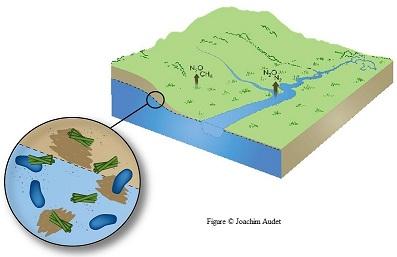Background

A riparian wetland is the area between land and water in the landscape. Often the area where groundwater is discharging to streams and rivers. Wetland soils are very effective to remove nitrogen compounds from surface and groundwater.
How? Specialized bacteria use nitrogen instead of oxygen to breath and additional use it for growth. Nitrate is removed to nitrogen gas. This is a stepwise process and carried out by four different groups of bacteria, as an end product bacteria release harmless nitrogen gas (N2) from the soil to the atmosphere. Organic material is a important food source for microorganism, therefore an important parameter to take into account.
Problems? The last decades has resulted in an increased use of nitrogen fertilizer and many wetlands have been drained. Nitrogen leaches to the surface and groundwater. This causes several environmental problems, such as lack of oxygen and algae blooms in surrounding waters.
Solution: These valuable functions have been attempted to be used. Therefore have restoration of wetlands been encourage in the entire European Union.
But: Under same favorable conditions are methane (CH4) and nitrous oxide (N2O) produced, which are effective greenhouse gases.
It is therefore very important to understand and identify which parameters are the most important for the nitrogen removal process and greenhouse gas production.
Responsible for this page:
Director of undergraduate studies Biology
Last updated:
05/02/12
